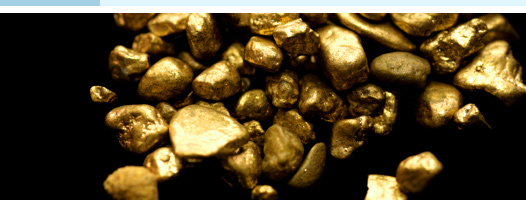
It is unaffected by moisture, oxygen, or ordinary acids but is attacked by the halogens. Aqua regia is so named for its ability to dissolve gold, the “king” of the metals. Gold forms both aurous (univalent) and auric (trivalent) compounds; auric chloride and chloroauric acid are its most common compounds.

Gold is widely distributed on the earth; although large amounts are present also in seawater, the cost of current methods for recovering it exceeds its value. Most gold is found in the metallic state in the form of dust, grains, flakes, or nuggets. It occurs, usually in association with silver or other metals, in quartz veins or lodes so finely disseminated that it is not visible.
It is found also in alluvial placer deposits, which are worked by panning, dredging, and hydraulic mining. Gold is extracted from its ores by mechanical means and separated from other metals by chemical processes, notably the cyanide process, the amalgamation process, and the chlorination process. It also occurs in compounds, notably telluride minerals. Gold has been known from prehistoric times and was possibly the first metal used by humans. It was valued for ornaments, and magical efficacy was attributed to it. In the Middle Ages alchemists sought to transmute baser metals into gold. The quest for gold stimulated European explorations and conquests in the Western Hemisphere, and its discovery has led to many a gold rush. Much of the gold now extracted is used for jewellery.
Gold has been known and highly valued since prehistoric times. It may have been the first metal used by humans and was valued for ornamentation and rituals. Egyptian hieroglyphs from as early as 2600 BCE describe gold, which king Tushratta of the Mitanni claimed was as "common as dust" in Egypt. Egypt and Nubia had the resources to make them major gold-producing areas for much of history.
Gold has long been considered one of the most precious metals, and its value has been used as the standard for many currencies (known as the gold standard) in history. Gold has been used as a symbol for purity, value, royalty, and particularly roles that combine these properties. Gold as a sign of wealth and prestige was made fun of by Thomas More in his treatise Utopia. On that imaginary island, gold is so abundant that it is used to make chains for slaves, tableware and lavatory-seats.
When ambassadors from other countries arrive, dressed in ostentatious gold jewels and badges, the Utopians mistake them for menial servants, paying homage instead to the most modestly-dressed of their party. There is an age-old tradition of biting gold in order to test its authenticity.
Although this is certainly not a professional way of examining gold, the bite test should score the gold because gold is considered a soft metal according to the Mohs' scale of mineral hardness. The purer the gold the easier it should be to mark it. Painted lead can cheat this test because lead is softer than gold.
Gold in antiquity was relatively easy to obtain geologically; however, 75% of all gold ever produced has been extracted since 1910.[3] It has been estimated that all the gold in the world that has ever been refined would form a single cube 20 m (66 ft) on a side (8000 m³). During the 19th century, gold rushes occurred whenever large gold deposits were discovered, including the California, Colorado, Otago, Australia, Witwatersrand, Black Hills, and Klondike gold rushes.





